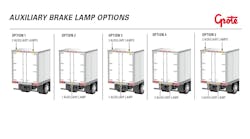Lighting supplier Grote Industries is asking federal truck regulators for permission to try pulsating brake lights on all trailers and van body trucks, a request that is similar to recent filings on behalf of tank truck carriers—one of which the Federal Motor Carrier Safety Administration has already approved.
The Grote filing, posted May 12, asks FMCSA to exempt Grote on behalf of commercial motor carriers from the 49 C.F.R. § 393.25(e) requirement that all trailers and van body trucks be equipped with steady burning brake lamps.
Grote requests a 5-year temporary exemption “because research has demonstrated that use of pulsating brake lamps increases visibility of equipment and vehicles. Use of pulsating brake activated warning lamps, in addition to steady burning red brake lamps as required by the Federal Motor Carrier Safety Regulations (FMCSRs), would allow commercial carriers to not only maintain operational safety levels, but also implement more efficient and effective operations.”
Grote notes that the request is very similar to exemptions which already exist for other classes of commercial motor vehicle operators, including “operators of tanker trailers, school bus operators, tow truck operators, and operators of vehicles transporting oversized loads.”
Indeed, the Grote filing comes just over a year after tank truck carrier Groendyke Transport Inc. was granted permission to install an amber brake-activated pulsating lamp on its tank trailers in addition to the steady-burning brake lamps required by the FMCSRs. Supporting its case, Groendyke in 2015 began testing an amber brake-activated pulsating lamp on some of its fleet without authorization from FMCSA.
Data gathered by Groendyke between January 2015 and July 2017 showed that trailers equipped with both the pulsating lamp and the steady-burning brake lamps were involved in 33.7% fewer rear-end collisions as compared to vehicles equipped with only the steady-burning brake lamps.
In its approval of a 5-year limited exemption, FMCSA called the test results “both persuasive and compelling given the magnitude of the rear-end crash population.”
“FMCSA believes that this real-world experience, along with the FMCSA and NHTSA research programs that demonstrated the ability of alternative rear signaling systems to reduce the frequency and severity of rear-end crashes, is sufficient to conclude that the implementation of an amber brake-activated pulsating lamp on the rear of Groendyke's trailers is likely to provide a level of safety that is equivalent to, or greater than, the level of safety achieved without the exemption,” the approval states.
The National Tank Truck Carriers has since followed the Groendyke approval with an April 2 request permitting any tank trailer to use red or amber brake-activated pulsating lamp. In the public comment period that formally closed May 4, trucking and safety organizations, along with numerous representatives of tanker fleets, expressed support for the NTTC request.
The American Trucking Associations suggested that FMCSA should work with the Technology & Maintenance Council (TMC) in developing a recommended practice (RP) that supports the pulsating lamp spec’ing consistency. ATA is not aware of a standard involving the location, pulsating speed/timing, color, and light intensity for commercial vehicle brake-activated pulsating rear lighting (or enhanced rear signaling, ERS) or as a best practice for installing, maintaining, involving these conditions.
ATA also reiterated comments submitted on the Groendyke exemption request that pointed to previous DOT reports and research, and noted that motor carriers recognize the potential of ERS for improving safe operations when compared with traditional standard brake lamps. In addition to safety benefits, ERS performance is superior to steady burning brake lamps in severe weather conditions, taillight glare and around infrastructure obstacles, ATA added. ERS also reduces the chances of damage to both vehicles involved in a rear-end crash, which improves commercial operation uptime, CSA scores for the CMV owner, and traffic inconvenience.
Voicing its support for NTTC’s exemption request, the Transportation Safety Equipment Institute also provided FMCSA with a number of recommendations for consideration in tailoring the terms of the request, or in considering possible amendments to the FMCSRs to accommodate wider use of pulsating lamps on commercial vehicles.
The Commercial Vehicle Safety Alliance, while supporting the safety benefits of amber brake-activated pulsating lamps, is opposed to motor carriers being permitted to equip the tank trailers with red brake-activated pulsating lamps.
“Pulsating red lamps are typically associated with emergency vehicles. Allowing red pulsating lamps on the rear of tank trailers may negatively impact the driving public’s recognition and response to emergency vehicles,” CVSA said. “Further, many states have laws prohibiting nonemergency vehicles from having pulsating red lights. If the exemption allows for the installation of red pulsating lights, it would be in direct conflict with state laws in several states.”
Comments on the Grote request must be received on or before June 11. They may be submitted online here.










